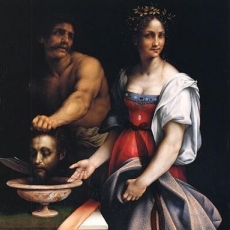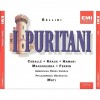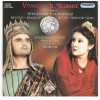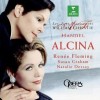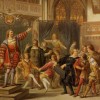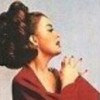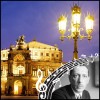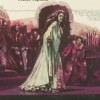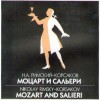Libretto
Synopsis
Olive Fremstad holding the head of John the Baptist in the Metropolitan Opera's 1907 production of Salome by Richard StraussA great terrace in the Palace of Herod, set above the banqueting-hall. Some soldiers are leaning over the balcony. To the right there is a gigantic staircase, to the left, at the back, an old cistern surrounded by a wall of green bronze. The moon is shining very brightly.
Narraboth gazes from a terrace in Herod's palace into the banquet hall at the beautiful Princess Salome; he is in love with her, and apostrophizes her, much to the disgustful fearfulness of the Page of Herodias. The voice of the Prophet Jochanaan is heard from his prison in the palace cistern; Herod fears him and has ordered that no one should contact him, including Jerusalem's High Priest.
Tired of the feast and its guests, Salome flees to the terrace. When she hears Jochanaan cursing her mother (Herodias), Salome's curiosity is piqued. The palace guards will not honor her petulant orders to fetch Jochanaan for her, so she teasingly works on Narraboth to bring Jochanaan before her. Despite the orders he has received from Herod, Narraboth finally gives in after she promises to smile at him.
Jochanaan emerges from the cistern and shouts prophesies regarding Herod and Herodias that no one understands, except Salome when the Prophet refers to her mother. Upon seeing Jochanaan, Salome is filled with an overwhelming desire for him, praising his white skin but he rejects her. She then praises his black hair and is rejected once more. She finally begs for a kiss from Jochanaan's lips, and Narraboth, who cannot bear to hear this, kills himself. As Jochanaan is returned to the well, he preaches salvation through the Messiah.
Herod enters, followed by his wife and court. He slips in Narraboth's blood and starts hallucinating. He hears the beating of wings. Despite Herodias' objections, Herod stares lustfully at Salome, who rejects him. Jochanaan harasses Herodias from the well, calling her incestuous marriage to Herod sinful. She demands that Herod silence him. Herod refuses, and she mocks his fear. Five Jews argue concerning the nature of God. Two Nazarenes tell of Christ's miracles; at one point they bring up the raising of Lazarus from the dead, which Herod finds frightening.
Herod asks for Salome to eat with him, drink with him; indolently, she twice refuses, saying she is not hungry or thirsty. Herod then begs Salome to dance for him, Tanz für mich, Salome, though her mother objects. He promises to reward her with her heart's desire — even if it were one-half of his kingdom.
After Salome inquires into his promise, and he swears to honor it, she prepares for the Dance of the Seven Veils. This dance, very oriental in orchestration, has her slowly removing her seven veils, until she lies naked at his feet. Salome then demands the head of the prophet on a silver platter. Her mother cackles in pleasure. Herod tries to dissuade her with offers of jewels, peacocks, and the sacred veil of the Temple. Salome remains firm in her demand for Jochanaan's head, forcing Herod to concede to her demands. After a desperate monologue by Salome, the head of the prophet is brought up out of the well and presented to Salome as she requested.
Salome declares her love to the severed head, finally kissing the prophet's lips passionately. Disgusted, the terrified and superstitious Herod then orders his soldiers to kill Salome.
Music
The music of Salome includes a system of leitmotifs, or short melodies with symbolic meanings. Some are clearly associated with people such as Salome and Jochanaan (John the Baptist). Others are more abstract in meaning.Strauss's use of leitmotifs is complex, with both symbolism and musical form subject to ambiguity and transformation. Some leitmotifs, especially those associated with Herod, change frequently in form and symbolic meaning, making it futile to pin them down to a specific meaning.Strauss provided names for some of the leitmotifs, but not consistently, and other people have assigned a variety of names. These names often illustrate the ambiguity of certain leitmotifs. For example, Gilman's labels tend to be abstract (such as "Yearning", "Anger", and "Fear"), while Roese more concrete (he called Gilman's "Fear" leitmotif "Herod's Scale"). Regarding the important leitmotif associated with Jochanaan, which has two parts, Gilman called the first part "Jochanaan" and the second part "Prophecy", while Roese labels them the other way around. Labels for the leitmotifs are common, but there is no final authority. Derrick Puffett cautions against reading too much into any such labels.In addition to the leitmotifs, there are many symbolic uses of musical color in the opera's music. For example, a tambourine sounds every time a reference to Salome's dance is made.
The harmony of Salome makes use of extended tonality, chromaticism, a wide range of keys, unusual modulations, tonal ambiguity, and polytonality. Some of the major characters have keys associated with them, such as Salome and Jochanaan, as do some of the major psychological themes, such as desire and death.
The role of Salome
The vocal demands of the Salome role are the same as those of an Isolde, Brünnhilde, or Turandot, in that, ideally, the role requires the volume, stamina, and power of a true dramatic soprano. The common theme of these four roles is the difficulty in casting an ideal soprano that has a truly dramatic voice as well as being able to register as a young woman.
In addition to the vocal and physical demands, the role also calls for the agility and gracefulness of a prima ballerina when performing the opera's famous "Dance of the Seven Veils". Finding one individual with all of these qualities is extremely daunting. Nevertheless, Maria Cebotari, Ljuba Welitsch, Birgit Nilsson, Leonie Rysanek, Radmila Bakočević, Montserrat Caballé, Anja Silja, Phyllis Curtin, Karan Armstrong, Teresa Stratas (on film), Nancy Shade, Cheryl Studer (on record), Dame Gwyneth Jones, Catherine Malfitano, Hildegard Behrens, Maria Ewing, Karita Mattila, and Deborah Voigt are among the most memorable who have tackled the role in the last half-century. Each of these singers has brought her own interpretation to the title character.
Perhaps the most famous recording of the opera is Sir Georg Solti's Decca recording with Birgit Nilsson as Salome. Due to the complexity of the role's demands, some of its performers have had a purely vocal focus by opting to leave the dancing to stand-ins who are professional dancers. Others have opted to combine the two and perform the dance themselves, which is closer to Strauss' intentions. In either case, at the end of the "Dance of the Seven Veils", some sopranos (or their stand-ins) wear a body stocking under the veils, while others (notably Malfitano, Mattila and Ewing) have appeared nude at the conclusion of the dance.
As for the required vocal-range of the title role, it is an extraordinary case: The highest note is the high B, not irregular for a soprano or mezzo-soprano to sing, while the lowest note is a low G-flat, in the alto-range and officially below the standard range for a mezzo-soprano. Considering this range, which is similar to many mezzo roles (such as "Carmen" and "Amneris"), one might assume that a high soprano is not essential to the piece, but it is; most of the relatively low sopranos who attempted this role found themselves straining their voices throughout the opera, and having reached the closing scene (the most important part of the opera for the title role) were very fatigued. This role is the classic example of the difference between tessitura and absolute range: While mezzos can perform a high note (like "Carmen"), or even temporarily sustain a high tessitura, it is impossible for a singer to spend such a long time (with the needed strength and breath-control) in the second octave above the middle C unless she is a high soprano. Moreover, the low G-flat occurs twice in the opera, and in both cases it is in pp—more of a theatrical effect than music—and can be growled instead of sung. The other low notes required are no lower than low A-natural, and they are also quiet.
Controversy
The combination of the biblical theme, the erotic and the murderous which so attracted Wilde to the tale shocked opera audiences from its first appearance. The original performers were very reluctant to handle the material as written, it was banned in London by the Lord Chamberlain's office until 1907, and Gustav Mahler could not gain the consent of the Vienna censor to have it performed, but it was eventually premiered in 1918. When it did premiere in London under Thomas Beecham, it was modified, much to Beecham's annoyance and later amusement. In New York, the premiere was suppressed by wealthy patrons, who entreated the visiting Edward Elgar to lead the objections to the work. Elgar refused point-blank, stating that Strauss was "the greatest genius of the age".
The two versions of Salome
Oscar Wilde originally wrote his Salomé in French. Strauss saw the play in Lachmann's version and immediately set to work on the opera. It is rumored that even Wilde saw the musical potential of Salomé but there is no confirmation as to any intentions of having it turned into an opera.
Strauss composed the opera in German and that is the version that has become widely known. However Strauss made an alternate version in French, which is less known today, although Kent Nagano recorded it on Virgin Classics with Karen Huffstodt in the title role and José van Dam as Jochanaan.





